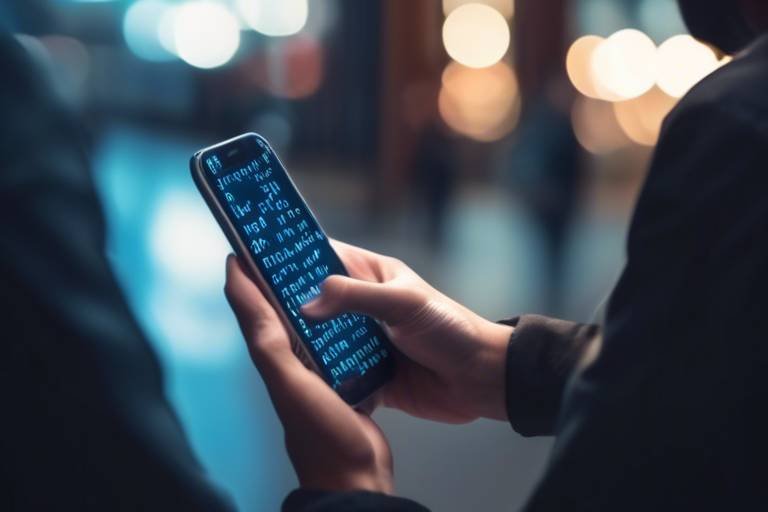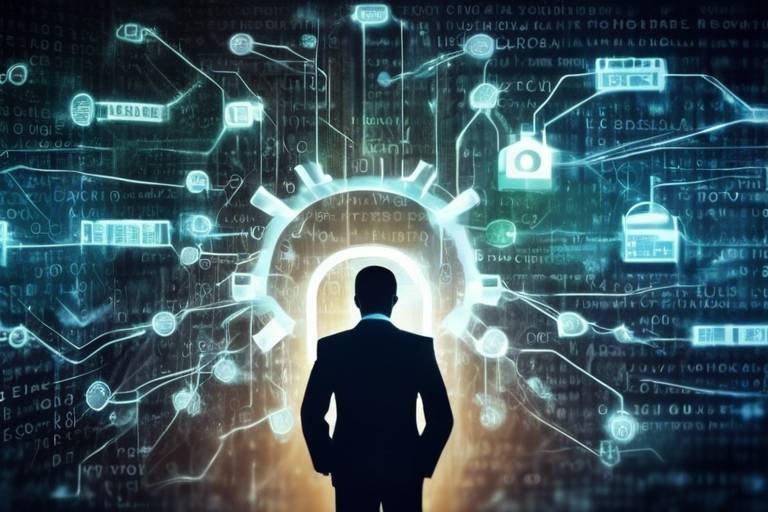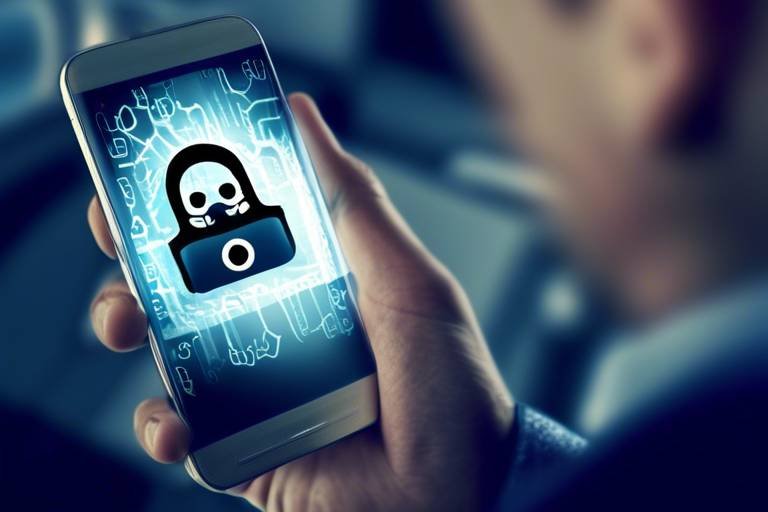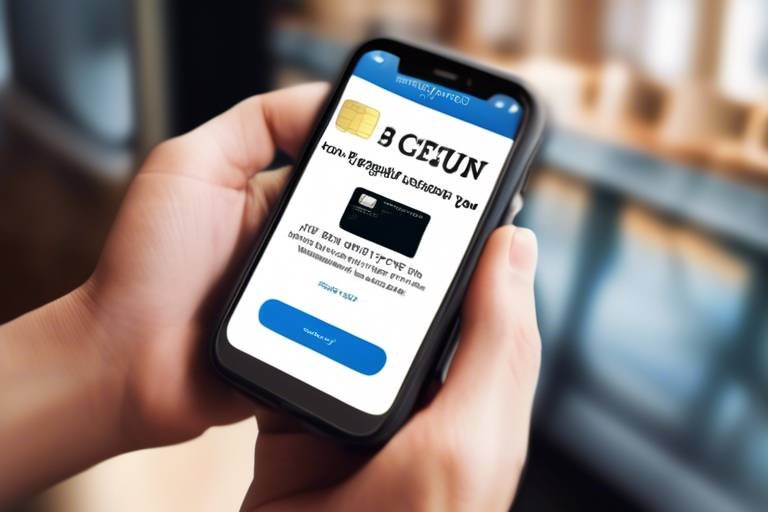How Secure Are Your Devices?
In today's world, where technology is intertwined with our daily lives, the question of security has never been more pressing. Devices ranging from smartphones to smart home gadgets are not just tools; they are gateways to our personal information, finances, and even our privacy. But how secure are these devices really? The truth is, while technology offers convenience, it also comes with vulnerabilities that can be exploited by cybercriminals. Understanding these vulnerabilities is the first step toward enhancing your digital safety.
The digital landscape is constantly evolving, and with it, the methods used by hackers to infiltrate devices. From outdated software to weak passwords, the entry points for cyber attacks are numerous. For instance, did you know that a staggering percentage of data breaches are caused by weak or reused passwords? This highlights the need for vigilance in securing our devices. As we delve deeper into this article, we'll explore various aspects of device security, from software updates to two-factor authentication, and provide you with practical tips to safeguard your digital life.
So, are you ready to take control of your device security? Let’s embark on this journey together, arming ourselves with knowledge and best practices to ensure our devices are as secure as possible. After all, in a world where cyber threats loom large, being proactive about security is not just a choice; it's a necessity.
To effectively protect your devices, it’s essential to identify the common vulnerabilities that exist. Many devices, particularly those that connect to the internet, can be susceptible to various forms of attack. Here are some typical weaknesses:
- Outdated Software: Failing to update your device's software can leave it open to exploits that have already been patched in newer versions.
- Weak Passwords: Using simple or common passwords makes it easier for attackers to gain access.
- Unsecured Networks: Connecting to public Wi-Fi without a VPN can expose your data to snoopers.
By being aware of these vulnerabilities, you can take steps to mitigate the risks and enhance the security of your devices.
Regular software updates are your first line of defense against cyber threats. These updates are designed to patch vulnerabilities, improve performance, and introduce new features that can enhance user experience. Ignoring updates is akin to leaving your front door wide open while you go on vacation—you're just inviting trouble! Keeping your devices up-to-date is crucial for maintaining security.
One of the simplest ways to ensure your devices are always protected is by enabling automatic updates. This feature allows your device to download and install updates without your intervention, ensuring you never miss a critical patch. Automating updates can save you time and provide peace of mind, knowing that your devices are consistently fortified against the latest threats.
If you prefer to manage updates manually, it's important to create a strategy that works for you. Consider setting a reminder to check for updates weekly or bi-weekly. This way, you can stay on top of the latest security patches without feeling overwhelmed. Remember, a little diligence goes a long way in keeping your devices secure!
Despite their importance, software updates can sometimes pose challenges, such as compatibility issues with older devices or user resistance to changes in interface. However, these challenges can often be overcome with a bit of research and patience. If you encounter issues, don't hesitate to consult support forums or customer service for assistance.
Strong passwords are a fundamental aspect of device security. Creating robust passwords is not just about complexity; it’s about uniqueness as well. Using the same password across multiple accounts is like using a master key for all your locks—if someone gets hold of it, they can access everything! Aim for passwords that are at least 12 characters long, combining letters, numbers, and symbols. Consider using a password manager to keep track of your unique passwords securely.
Two-factor authentication (2FA) adds an extra layer of security to your devices. It requires not only a password but also a second form of verification, such as a code sent to your phone. This means that even if someone manages to crack your password, they won't be able to access your account without that second factor. Enabling 2FA is a simple yet effective way to enhance your security.
There are several methods of 2FA, each with its own security levels and usability. Common methods include:
- SMS Codes: A code is sent to your phone via text message.
- Authentication Apps: Apps like Google Authenticator generate time-sensitive codes.
While SMS codes are convenient, authentication apps are generally considered more secure, as they are less susceptible to interception.
While 2FA significantly enhances security, it can also lead to user frustration. Common pitfalls include losing access to your second factor or dealing with authentication delays. To navigate these challenges, ensure you have backup codes stored securely and familiarize yourself with the 2FA process on each platform you use.
A secure network is vital for protecting your devices from unauthorized access. Start by using strong Wi-Fi passwords and enabling encryption on your router. This ensures that only authorized users can connect to your network, significantly reducing the risk of intrusions.
Firewalls act as a barrier between your devices and potential threats from the internet. They monitor incoming and outgoing traffic, blocking unauthorized access while allowing legitimate communication. Installing a firewall is an essential step in safeguarding your devices from cyber attacks.
Using a Virtual Private Network (VPN) can greatly enhance your online privacy and security. VPNs encrypt your internet connection, making it difficult for hackers to intercept your data. This is especially important when using public Wi-Fi networks, where threats are rampant. By masking your IP address, a VPN provides an additional layer of protection, ensuring your online activities remain private.
Q: How often should I update my devices?
A: It's best to check for updates at least once a week or enable automatic updates to ensure you're always protected.
Q: What makes a password strong?
A: A strong password should be at least 12 characters long, include a mix of letters, numbers, and symbols, and be unique to each account.
Q: Is two-factor authentication really necessary?
A: Yes! 2FA adds a crucial layer of security, making it much harder for unauthorized users to access your accounts.
Q: How can I secure my home network?
A: Use strong passwords, enable encryption, and consider setting up a guest network for visitors.

Understanding Device Vulnerabilities
In our hyper-connected world, the security of our devices has never been more crucial. Every gadget we own, from smartphones to smart TVs, is a potential target for cybercriminals. But what makes these devices so vulnerable? Understanding the underlying issues is the first step toward fortifying your digital defenses.
One of the most significant vulnerabilities lies in outdated software. Manufacturers regularly release updates to patch security holes that hackers can exploit. If you ignore these updates, you're essentially leaving the door wide open for intruders. Imagine your device as a house; if you neglect to fix a broken window, you're inviting trouble. Keeping your software current is like reinforcing those windows and doors.
Another common pitfall is the use of weak passwords. Many people still opt for easily guessable passwords like "123456" or "password." This is akin to using a flimsy lock on your front door. A strong password should be a mix of letters, numbers, and symbols, and it should be unique for every account. This way, if one account is compromised, others remain secure.
Additionally, many devices connect to unsecured networks. Public Wi-Fi may seem convenient, but it can be a hacker's playground. When you connect to an unsecured network, it’s like sending your personal information through a glass window for anyone to see. Always use a secure connection, and consider using a VPN to encrypt your data when accessing public networks.
To summarize, the primary vulnerabilities that can jeopardize your device's security include:
- Outdated Software: Regular updates are essential.
- Weak Passwords: Strong, unique passwords are a must.
- Unsecured Networks: Avoid public Wi-Fi or use a VPN.
By being aware of these vulnerabilities, you can take proactive steps to protect your devices. Remember, security is not a one-time fix but an ongoing process. In the next section, we’ll discuss the importance of regular software updates and how they can significantly enhance your device's defenses.

Importance of Regular Software Updates
In today's fast-paced digital world, regular software updates are not just a good practice; they are essential for maintaining the security and performance of your devices. Think of your device's software as a living organism that needs constant care and attention. Just like how our bodies require regular check-ups to fend off illnesses, your devices need updates to protect against vulnerabilities and ensure they function optimally. When software developers release updates, they often include patches for security flaws that could be exploited by cybercriminals. If you ignore these updates, you’re essentially leaving your digital front door wide open for hackers to waltz right in!
Moreover, updates do more than just fix security issues. They can also enhance the overall performance of your device. Imagine driving a car that hasn’t had an oil change in years; it’s not going to run smoothly. Similarly, outdated software can lead to sluggish performance, crashes, and compatibility issues with new applications. Regular updates are like tuning your car to ensure it runs smoothly and efficiently.
To give you a clearer picture, here’s a quick breakdown of what happens when you neglect software updates:
| Consequence | Description |
|---|---|
| Increased Vulnerability | Outdated software is more susceptible to attacks, making it easier for hackers to exploit known flaws. |
| Performance Issues | Neglecting updates can lead to bugs, crashes, and slow performance, frustrating your user experience. |
| Compatibility Problems | New applications may not work well with older software, leading to further complications. |
Now, you might be wondering, “How do I keep track of all these updates?” Well, many devices offer settings to notify you when updates are available. It’s wise to take advantage of these notifications. Additionally, consider setting a recurring reminder on your calendar to check for updates manually if you prefer that approach. Remember, staying updated is a proactive step towards safeguarding your digital life!
In conclusion, the importance of regular software updates cannot be overstated. They are a critical line of defense against cyber threats and ensure your devices perform at their best. So, don’t wait—make it a habit to regularly update your software and keep your digital environment secure!
- How often should I update my software? It’s best to check for updates at least once a month, but enabling automatic updates can save you the hassle.
- What if I miss an update? If you miss an update, don’t panic! Just install it as soon as you can to ensure your device is protected.
- Are software updates free? Yes, most software updates are free of charge, especially for operating systems and applications.

Automating Updates
In today’s fast-paced digital world, is not just a convenience; it’s a necessity. Imagine trying to keep up with the latest security patches and software improvements manually—it’s like trying to catch a speeding train! By enabling automatic updates, you can ensure that your devices are always running the latest software without the hassle of remembering to check for updates regularly. This proactive approach significantly reduces the risk of vulnerabilities being exploited by cybercriminals, who are constantly on the lookout for outdated systems.
One of the key benefits of automating updates is that it allows you to focus on what really matters—using your devices without the nagging worry of potential security threats. When updates are automated, you can rest easy knowing that your software is being maintained in the background. Most modern operating systems and applications have built-in options to enable automatic updates, and it’s usually just a few clicks away. For instance, on Windows, you can navigate to Settings > Update & Security > Windows Update and toggle the automatic update feature. Similarly, macOS users can find this option under System Preferences > Software Update.
However, it’s important to note that not all updates are created equal. While security patches are critical, some updates may introduce changes that affect how you use your device. This is why it’s wise to periodically check the update history of your devices to understand what changes have been made. You might find that some updates improve performance, while others may require you to adapt to new features or interfaces. To help you better understand the types of updates, here’s a quick overview:
| Type of Update | Description |
|---|---|
| Security Updates | Fix vulnerabilities that could be exploited by hackers. |
| Feature Updates | Introduce new functionalities or enhancements. |
| Performance Updates | Improve the speed and efficiency of the software. |
While automating updates is beneficial, there can be some challenges. For example, if you’re using older hardware, certain updates might not be compatible, leading to performance issues. To mitigate this, consider scheduling updates during off-peak hours or when you’re not using your device heavily. This way, you can enjoy the benefits of being up-to-date without interruptions.
In conclusion, automating updates is a straightforward yet powerful way to enhance your device security. By taking this proactive step, you can significantly reduce your chances of falling victim to cyber threats. So, take a moment to check your settings today and let your devices do the heavy lifting when it comes to staying secure!
- What types of updates should I automate? Focus on security updates and performance enhancements, as these are crucial for maintaining device safety.
- Can I control when updates are installed? Yes, most operating systems allow you to schedule updates for specific times.
- What if an update causes issues? If you experience problems after an update, you can often roll back to a previous version or seek help from the software provider.

Manual Update Strategies
When it comes to keeping your devices secure, manually managing software updates can feel a bit like walking a tightrope—balancing between the need for security and the desire for convenience. If you prefer to take control of your updates, there are effective strategies you can implement to ensure your devices remain secure without getting overwhelmed. First and foremost, setting a regular schedule for updates is crucial. Just like you wouldn’t skip your regular health check-ups, your devices need their own tune-ups. Block out a specific time each week or month to check for updates. This routine can help you stay on top of the latest patches and features.
Another effective strategy involves creating a checklist of all your devices and their respective software. Consider this your personal inventory of digital health. You can use a simple table format to track which devices need updates, the last time they were updated, and any upcoming updates scheduled. Here’s a quick example:
| Device | Last Update | Next Scheduled Update |
|---|---|---|
| Laptop | September 15, 2023 | October 15, 2023 |
| Smartphone | September 20, 2023 | October 20, 2023 |
| Router | August 30, 2023 | September 30, 2023 |
In addition to scheduling, it’s also wise to stay informed about the specific software you use. Many developers release newsletters or updates on their websites detailing the importance of their patches. By subscribing to these updates, you can gain insights into what vulnerabilities are being addressed and why they matter. This knowledge empowers you to prioritize updates based on the potential risks involved.
Another tip is to enable notifications for updates. Most operating systems and applications allow you to set alerts for when new updates are available. This way, you won’t have to remember to check manually; you’ll be reminded when it’s time to take action. However, be cautious—don’t just click 'update' without reading what the update entails. Sometimes, updates can introduce new features that might alter your user experience, and being aware of these changes can save you from unnecessary confusion.
Lastly, consider keeping a backup of your important data before performing updates. While updates are designed to improve security and functionality, there’s always a slight chance that something could go awry. By backing up your data, you’re safeguarding yourself against potential mishaps that could arise during the update process. Think of it as an insurance policy for your digital life.
In summary, while manual updates may require a bit more effort, they can significantly enhance your device's security. By establishing a routine, maintaining a checklist, staying informed, enabling notifications, and backing up your data, you can navigate the world of software updates with confidence and keep your devices safe from threats.
Q: How often should I check for manual updates?
A: It's recommended to check for updates at least once a month, but setting a weekly reminder can help ensure you don’t miss critical patches.
Q: Are manual updates more secure than automatic updates?
A: Manual updates allow you to control when and how updates are applied, but they require diligence. Automatic updates can be more convenient and ensure timely application of security patches.
Q: What should I do if an update causes issues?
A: If an update causes problems, you can often roll back to a previous version of the software. Always keep backups to restore your data if needed.
Q: Can I automate some updates while managing others manually?
A: Yes! Many systems allow you to set specific applications for automatic updates while leaving others for manual management.

Challenges of Updates
While keeping your devices updated is crucial for maintaining security, it’s not always a walk in the park. Many users face a range of challenges that can make the update process feel daunting. One of the most common issues is compatibility; sometimes, new updates can cause older software or hardware to malfunction. Imagine upgrading your favorite app only to find that it no longer works with your operating system. Frustrating, right?
Another significant hurdle is user resistance. Many people are simply not fond of change, and updates often come with new interfaces or features that can be overwhelming or confusing. This resistance can lead to procrastination in applying updates, leaving devices vulnerable to cyber threats. In fact, studies have shown that a substantial number of users delay updates due to fear of the unknown, which can be likened to holding onto a sinking ship because you’re afraid of swimming.
Moreover, updates can sometimes introduce bugs or performance issues, which can create a vicious cycle of distrust between users and the update process. It's essential to weigh the benefits against these potential drawbacks. To combat these challenges, users can adopt a few strategies:
- Research Before Updating: Take some time to read about what the update entails. Knowing what changes to expect can ease the transition.
- Backup Your Data: Always back up your important files before applying updates. This way, if something goes wrong, you won't lose your precious data.
- Stay Informed: Follow tech blogs or forums to learn about common issues others face after updates, which can help you prepare.
In summary, while updates are essential for security, they come with their own set of challenges. By understanding these hurdles and preparing for them, you can minimize the risks and enjoy the benefits of a more secure digital experience.
Q: Why are software updates important?
A: Software updates are crucial because they patch vulnerabilities, improve performance, and often introduce new features that enhance user experience and security.
Q: What should I do if an update causes problems?
A: If an update causes issues, you can try rolling back to the previous version if possible, or check online for solutions. Backing up your data beforehand can save you from losing important files.
Q: How can I ensure my updates are applied regularly?
A: You can enable automatic updates on most devices, which will ensure that your software is updated regularly without requiring your intervention.
Q: Are there risks associated with automatic updates?
A: While automatic updates are generally safe, they can occasionally introduce bugs. Keeping an eye on update notes and user feedback can help you stay informed.

Utilizing Strong Passwords
In today's digital landscape, strong passwords are your first line of defense against cyber threats. Think of your password as the lock on your front door; if it’s weak, you’re inviting trouble right in. A strong password is essential not only for protecting your personal information but also for safeguarding your devices from unauthorized access. But what makes a password strong? Generally, a strong password should be at least 12 characters long and include a mix of uppercase letters, lowercase letters, numbers, and special characters. For instance, instead of using a simple password like "password123," try something more complex, like "P@ssw0rd!2023".
Moreover, it's crucial to use unique passwords for different accounts. Imagine using the same key for your house, car, and office; if someone gets hold of that key, they have access to everything! The same principle applies to your digital life. If one account is compromised, using the same password across multiple platforms can lead to a domino effect, putting all your accounts at risk.
To make the process of creating and managing strong passwords easier, consider using a password manager. These tools can generate strong passwords for you and store them securely, so you don’t have to remember every single one. However, if you prefer to manage your passwords manually, here are some strategies:
- Phrase Method: Use a memorable phrase and modify it. For example, “I love to travel in 2023!” could become “ILuv2Tr@vel2023!”
- Random Words: Combine unrelated words to create a unique password. For instance, “BlueChair!Sunset7” is both strong and easy to remember.
- Substitutions: Replace letters with similar-looking numbers or symbols, like "E" with "3" or "A" with "@".
In conclusion, utilizing strong passwords is not merely a suggestion but a necessity in our increasingly connected world. By following best practices and employing tools like password managers, you can significantly enhance your security posture. Remember, your password is your first line of defense, so make it count!
Q: How often should I change my passwords?
A: It's advisable to change your passwords every 3-6 months, especially for sensitive accounts.
Q: Can I use a password manager for all my accounts?
A: Yes, password managers are designed to securely store and manage passwords for all your accounts.
Q: What should I do if I think my password has been compromised?
A: Immediately change your password and enable two-factor authentication on your account if available.

Implementing Two-Factor Authentication
In today's digital age, where cyber threats lurk around every corner, implementing two-factor authentication (2FA) is like adding an extra lock to your front door. It’s not just about having a strong password; it’s about ensuring that even if your password gets compromised, your accounts remain secure. So, how does 2FA work? Essentially, it requires not just something you know (your password), but also something you have (like a smartphone or a hardware token) to access your accounts. This additional layer of security significantly reduces the risk of unauthorized access.
Imagine waking up one day to find that your online bank account has been drained because someone guessed your password. Heart-stopping, right? With 2FA, even if someone manages to get hold of your password, they would still need your second factor to log in, making it much harder for them to succeed. This is particularly important for sensitive accounts, such as those related to finance, personal information, or work-related data.
Enabling 2FA is generally straightforward across most platforms. You can usually find the option in your account settings under security options. Once activated, you’ll receive a verification code via SMS, email, or through an authenticator app whenever you attempt to log in from a new device. This process not only secures your account but also gives you peace of mind knowing that your information is better protected.
However, while 2FA is a fantastic tool for enhancing security, it’s not without its quirks. Users might encounter frustrations, such as not receiving the verification code or losing access to their second factor. To mitigate these issues, it’s crucial to have backup methods in place. For example, many services provide backup codes that you can store safely, ensuring you can still access your account if you lose your phone or if your authentication app fails.
Moreover, it’s essential to understand the different types of 2FA methods available:
- SMS Codes: A code sent to your mobile device, which you enter to gain access.
- Authentication Apps: Apps like Google Authenticator or Authy generate time-sensitive codes for logging in.
- Hardware Tokens: Physical devices that generate codes or connect to your computer for authentication.
Each method has its pros and cons. For instance, SMS codes can be intercepted, while authentication apps are generally more secure. Choosing the right method for you depends on your comfort level and the sensitivity of the information you’re protecting. Ultimately, the goal is to make it as difficult as possible for cybercriminals to access your accounts.
In conclusion, implementing two-factor authentication is a critical step in protecting your digital life. By requiring a second form of verification, you drastically reduce the chances of unauthorized access. So, take a moment to enable 2FA on your important accounts today—it’s a small effort that can yield significant results in safeguarding your personal information.
- What is two-factor authentication? Two-factor authentication is a security process that requires two different forms of identification before granting access to an account.
- Why should I use 2FA? It adds an extra layer of security, making it harder for unauthorized users to access your accounts, even if they have your password.
- What happens if I lose my phone? Most services provide backup codes that you can use to access your account if you lose your second factor.
- Are SMS codes secure? While convenient, SMS codes are less secure than authentication apps due to the potential for interception.

Types of Two-Factor Authentication
When it comes to protecting your digital life, two-factor authentication (2FA) is like having a strong lock on your front door and a security guard watching over your property. It adds an extra layer of security to your accounts, making it much harder for cybercriminals to gain unauthorized access. But did you know that there are several types of 2FA methods available? Understanding these can help you choose the right one for your needs.
The most common types of two-factor authentication include:
- SMS Codes: This method sends a one-time code to your mobile phone via text message. While it's convenient, it can be vulnerable to interception, especially if your phone is compromised.
- Authentication Apps: Apps like Google Authenticator or Authy generate time-sensitive codes that you enter after your password. These codes are more secure than SMS codes since they don’t rely on your phone network.
- Email Verification: Some services send a verification link or code to your email address. While this adds a layer of security, it’s only as secure as your email account itself.
- Hardware Tokens: These are physical devices that generate codes for your account. They are highly secure but can be less convenient since you need to carry them around.
- Biometric Authentication: This method uses your unique biological traits, such as fingerprints or facial recognition, to verify your identity. It's incredibly secure and user-friendly, but not all devices support it.
Each of these methods has its own advantages and disadvantages. For instance, while SMS codes are easy to use, they can be intercepted by hackers. On the other hand, hardware tokens provide robust security but may not be practical for everyone. Therefore, it's essential to assess your personal needs and the level of security you require.
To make a wise choice, consider factors such as convenience, security level, and device compatibility. If you're frequently on the go and need quick access, an authentication app might be your best bet. However, if security is your top priority, a hardware token or biometric authentication could be worth the extra effort.
In conclusion, understanding the different types of two-factor authentication can empower you to make informed decisions about your digital security. By selecting the method that best aligns with your lifestyle and security needs, you can significantly enhance your protection against unauthorized access.
- What is two-factor authentication? Two-factor authentication is a security process that requires two different forms of identification before granting access to an account.
- Why is two-factor authentication important? It adds an additional layer of security beyond just a password, making it much harder for hackers to gain access to your accounts.
- Can I use multiple types of 2FA? Yes, many services allow you to enable multiple forms of two-factor authentication for added security.
- What should I do if I lose my 2FA device? Most services provide backup codes or recovery options to regain access if you lose your 2FA device.

Common Pitfalls of 2FA
While Two-Factor Authentication (2FA) is a powerful tool for enhancing security, it’s not without its challenges. Many users encounter common pitfalls that can lead to frustration or even compromise their security. One major issue is the reliance on SMS codes. While convenient, SMS-based 2FA can be vulnerable to interception, especially if your phone number is compromised. Imagine a thief gaining access to your phone number and receiving your authentication codes. It’s like giving them the keys to your digital kingdom!
Another common pitfall is forgetting to update your 2FA method when changing devices. Have you ever switched phones and forgotten to transfer your authentication app? This can lock you out of your accounts, leading to a frustrating recovery process. Additionally, some users find themselves overwhelmed by the number of accounts requiring 2FA, leading to a tendency to disable it altogether out of convenience. This is akin to locking your front door but leaving the back door wide open!
Furthermore, there’s the issue of backup codes. Many services provide backup codes that can be used if you lose access to your primary 2FA method. However, if users fail to store these codes securely, they may find themselves in a bind when they need them most. It’s critical to treat these codes like cash—keep them safe, and don’t let them slip through your fingers!
To navigate these pitfalls effectively, consider the following strategies:
- Use Authentication Apps: Instead of relying on SMS, opt for authentication apps like Google Authenticator or Authy, which generate codes directly on your device.
- Keep Backup Codes Safe: Store your backup codes in a secure password manager or a physical location that you can easily access.
- Stay Updated: Regularly check your 2FA settings when you change devices to ensure you don’t lose access.
By being aware of these common pitfalls and implementing some basic strategies, you can enjoy the enhanced security that 2FA offers without the headaches that often accompany it. Remember, security is a journey, not a destination. Stay vigilant, stay informed, and keep your digital life secure!
Q: What is Two-Factor Authentication?
A: Two-Factor Authentication (2FA) is a security process that requires two different forms of identification before granting access to an account. This typically includes something you know (like a password) and something you have (like a phone or authentication app).
Q: Why should I use 2FA?
A: 2FA significantly enhances your security by adding an extra layer of protection. Even if someone obtains your password, they cannot access your account without the second factor.
Q: What if I lose my phone with my 2FA app?
A: Most services provide backup codes for situations like this. It’s essential to keep these codes in a secure location to regain access to your accounts.
Q: Are there any downsides to using 2FA?
A: While 2FA increases security, it can sometimes lead to inconvenience, especially if you forget your second factor or if your device is lost or stolen. However, the benefits generally outweigh the drawbacks.

Securing Your Network
In our hyper-connected world, securing your network is more important than ever. Imagine your home or office network as a digital fortress; if the walls are weak, intruders can easily breach your defenses. A secure network not only protects your devices from unauthorized access but also safeguards your sensitive information from cybercriminals. So, how can you fortify your digital fortress? Let's dive into some essential strategies that can help you secure your network effectively.
First and foremost, using a strong Wi-Fi password is crucial. A weak password is like leaving the front door of your house wide open. Aim for a password that is at least 12 characters long and includes a mix of letters, numbers, and symbols. Avoid common phrases or easily guessed information, such as birthdays or pet names. Consider using a password manager to generate and store complex passwords securely. This way, you won’t have to rely on your memory alone, and you can easily create unique passwords for different accounts.
Another vital aspect of network security is enabling encryption. Most modern routers come with built-in encryption options, such as WPA3, which is the latest and most secure protocol. Encryption scrambles the data transmitted over your network, making it incredibly difficult for hackers to intercept and read. To enable encryption, log into your router's settings page and select the appropriate security protocol. If you're unsure how to do this, consult your router's manual or look for online guides tailored to your specific model.
Additionally, regularly updating your router's firmware is essential for maintaining security. Just like software on your devices, router firmware can have vulnerabilities that need to be patched. Manufacturers often release updates that address security flaws and improve performance. To check for updates, access your router's settings and look for a firmware update option. Keeping your router up-to-date ensures that you have the latest security features and fixes.
Firewalls also play a critical role in securing your network. Think of a firewall as a security guard that monitors incoming and outgoing traffic. It can block unauthorized access and alert you to suspicious activity. Most routers come with a built-in firewall, but you can also install additional software firewalls on your devices for extra protection. Configuring your firewall settings properly can help you create a more secure environment for your network.
Lastly, consider using a Virtual Private Network (VPN) to enhance your online privacy and security further. A VPN creates a secure tunnel between your device and the internet, encrypting your data and masking your IP address. This makes it much harder for hackers or snoopers to track your online activities. Whether you're browsing at home or using public Wi-Fi, a VPN adds an extra layer of security that is worth considering.
In summary, securing your network is not just about having a strong password; it involves a comprehensive approach that includes encryption, firmware updates, firewalls, and possibly a VPN. By taking these steps, you can significantly reduce the risk of unauthorized access and protect your sensitive information from cyber threats. Remember, in the digital age, a little caution goes a long way in ensuring your online safety.
- What is the best way to secure my home Wi-Fi network?
Use a strong password, enable WPA3 encryption, and regularly update your router's firmware. - Do I need a firewall if I have a VPN?
Yes, a firewall provides an additional layer of security, even when using a VPN. - How often should I change my Wi-Fi password?
It's a good practice to change your Wi-Fi password every 6 to 12 months or immediately if you suspect a breach.

Importance of Firewalls
When it comes to securing your devices, one of the most essential tools at your disposal is a firewall. Think of a firewall as a digital barrier, much like a security guard at the entrance of a building, allowing only authorized personnel to enter while keeping intruders at bay. This protective layer can be implemented in both hardware and software forms, making it versatile for various setups.
A firewall's primary function is to monitor and control incoming and outgoing network traffic based on predetermined security rules. It acts as a filter, blocking malicious traffic while permitting legitimate requests. Without a firewall, your devices are like open doors, inviting cybercriminals to exploit vulnerabilities. Here are some of the key reasons why firewalls are indispensable:
- Protection Against Unauthorized Access: Firewalls prevent unauthorized users from accessing your network and devices, significantly reducing the risk of data breaches.
- Monitoring Traffic: Firewalls keep an eye on all traffic entering and leaving your network, allowing you to detect suspicious activities early.
- Blocking Malware: Many firewalls can detect and block known malware, keeping your system safe from harmful software.
- Customizable Security Rules: You can tailor the firewall settings to fit your specific needs, allowing for enhanced security based on your unique environment.
Moreover, firewalls can also help in preventing the spread of malware within your network. If one device becomes compromised, a firewall can stop the malware from reaching other connected devices, acting as a containment measure. This is particularly crucial in environments with multiple devices, such as home networks or corporate settings.
It's also worth noting that while firewalls provide a solid line of defense, they are not a standalone solution. They should be part of a comprehensive security strategy that includes regular software updates, strong passwords, and other security measures. In essence, think of a firewall as a crucial piece of a larger puzzle, working alongside other tools to create a robust security framework.
In conclusion, the importance of firewalls cannot be overstated. They serve as a frontline defense mechanism against a myriad of cyber threats, safeguarding your devices and sensitive information. Whether you're a casual internet user or managing a complex network, investing in a reliable firewall is a smart move towards ensuring your digital safety.
- What is a firewall? A firewall is a security device or software that monitors and controls incoming and outgoing network traffic based on security rules.
- Do I need a firewall if I have antivirus software? Yes, firewalls and antivirus software serve different purposes and should be used together for optimal protection.
- Can a firewall prevent all cyber attacks? While firewalls provide essential protection, they cannot prevent all cyber attacks. They should be part of a layered security approach.

VPNs for Enhanced Privacy
In today's digital age, where our every click can be tracked and our data can be compromised, using a Virtual Private Network (VPN) has become more than just a luxury—it's a necessity. A VPN is like a secure tunnel that encrypts your internet connection, making it nearly impossible for anyone to snoop on your online activities. Imagine walking through a crowded marketplace with a cloak that makes you invisible; that’s what a VPN does for your online presence.
When you connect to the internet through a VPN, your data is routed through a server operated by the VPN provider, which masks your IP address and encrypts your data. This means that not only are your browsing habits shielded from prying eyes, but your sensitive information, such as passwords and credit card numbers, is also safeguarded from hackers. In a world where data breaches are alarmingly common, this added layer of security is invaluable.
Furthermore, VPNs can help you bypass geographical restrictions, allowing you to access content that may be blocked in your region. Whether you want to stream your favorite show from another country or access websites that are typically restricted, a VPN grants you the freedom to surf the web without limitations. However, it’s crucial to choose a reputable VPN service that prioritizes your privacy and does not log your activity.
Here are some key benefits of using a VPN:
- Enhanced Security: Encrypts your internet connection, protecting your data from cyber threats.
- Privacy Protection: Masks your IP address, keeping your online activities anonymous.
- Bypass Restrictions: Access content that may be blocked based on your geographical location.
- Secure Public Wi-Fi: Protects your data when using unsecured networks, such as those in cafes or airports.
While the advantages are clear, it's also important to be aware of potential drawbacks. For instance, using a VPN can sometimes slow down your internet speed, as your data has to travel longer distances and through additional servers. However, many premium VPN services offer high-speed connections that minimize this issue. Additionally, not all VPNs are created equal; some may have questionable privacy policies or inadequate security measures, so it's essential to do your research before committing to a service.
In summary, a VPN is a powerful tool that enhances your online privacy and security. By encrypting your data and masking your IP address, it allows you to browse the web with confidence, knowing that your personal information is protected. As we continue to rely on technology for our daily activities, investing in a reliable VPN service is a step towards ensuring your digital safety.
1. What is a VPN?
A VPN, or Virtual Private Network, is a service that encrypts your internet connection and hides your IP address, providing enhanced privacy and security while browsing online.
2. Do I really need a VPN?
Yes, especially if you frequently use public Wi-Fi networks or want to maintain your privacy while browsing the internet.
3. Can a VPN slow down my internet speed?
It can, but many premium VPN services are designed to minimize speed loss, ensuring a smooth browsing experience.
4. Are all VPNs safe to use?
No, it’s important to choose a reputable VPN provider that has a strong privacy policy and does not log your activity.
5. Can I use a VPN on my mobile device?
Absolutely! Most VPN services offer apps for both Android and iOS, allowing you to secure your mobile browsing.
Frequently Asked Questions
- What are common vulnerabilities in devices?
Common vulnerabilities include outdated software, weak passwords, and unsecured networks. Cybercriminals often exploit these weaknesses, making it crucial to stay informed about potential risks.
- Why are regular software updates important?
Regular software updates are essential because they patch vulnerabilities, improve performance, and introduce new features. Keeping your devices updated helps protect against the latest threats.
- How can I automate software updates?
You can automate software updates by enabling the automatic update feature in your device settings. This ensures that your device receives the latest security patches without manual intervention.
- What strategies can I use for manual updates?
If you prefer manual updates, set a regular schedule to check for updates. Prioritize critical updates and keep a list of your devices to ensure you don’t miss any important patches.
- What are strong password practices?
Strong password practices include creating complex passwords that are at least 12 characters long, using a mix of letters, numbers, and symbols, and avoiding easily guessable information like birthdays.
- What is two-factor authentication (2FA)?
Two-factor authentication (2FA) adds an extra layer of security by requiring a second form of verification, such as a text message or authentication app, in addition to your password.
- What are the different types of 2FA methods?
Common types of 2FA methods include SMS codes, authentication apps, and hardware tokens. Each method has its pros and cons, so choose one that balances security and convenience for you.
- What are the common pitfalls of 2FA?
Common pitfalls of 2FA include losing access to your second factor, such as a phone or token, and frustration with the extra steps. To avoid these issues, keep backup codes and choose user-friendly methods.
- How can I secure my home network?
To secure your home network, use a strong Wi-Fi password, enable encryption, and regularly update your router’s firmware. Consider setting up a guest network for visitors to keep your main network secure.
- What role do firewalls play in network security?
Firewalls act as a barrier between your devices and potential threats from the internet. They monitor incoming and outgoing traffic, blocking unauthorized access and helping to protect your network.
- How do VPNs enhance online privacy?
VPNs (Virtual Private Networks) encrypt your internet connection, making it difficult for third parties to track your online activities. They also allow you to access content securely, even on public networks.



















